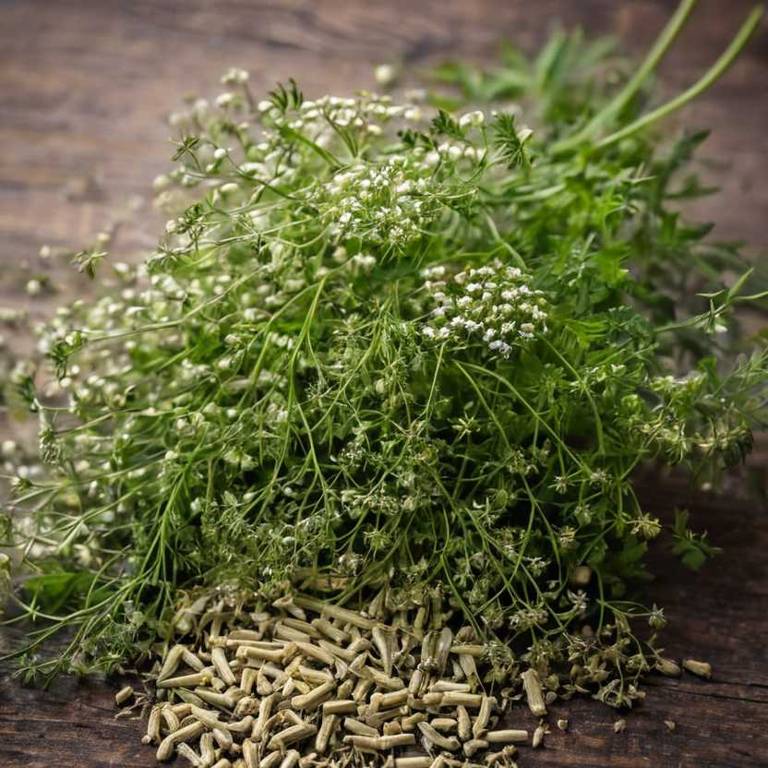By Leen Randell
Updated: Jul 21, 2024
10 Medicinal Constituents Of Anthriscus Sylvestris (Wild Chervil)

Anthriscus sylvestris has active constituents such as flavonoids, volatile oils, and coumarins.
These constituents possess anti-inflammatory, antioxidant, and antispasmodic properties, which can help alleviate digestive issues, reduce inflammation, and soothe respiratory problems. For example, the flavonoids can improve cardiovascular health by reducing blood pressure, while the volatile oils may ease menstrual cramps and promote relaxation.
Overall, the medicinal properties of wild chervil can significantly enhance the quality of life for individuals suffering from various health conditions.
This article explains in details the 10 best active constituents of Anthriscus sylvestris.
1. Osthole
Anthriscus sylvestris osthole is a bioactive compound isolated from the roots of this plant.
It has been traditionally used in Chinese medicine for centuries to treat various health issues, including inflammation, cardiovascular diseases, and cancer.
Osthole has been shown to exhibit anti-inflammatory, antioxidant, and anticancer properties, making it a promising natural remedy with potential therapeutic applications.
2. Falcarinol
Anthriscus sylvestris falcarinol is a sesquiterpene lactone compound found in the plant's leaves and stems.
This bioactive compound has been shown to possess various pharmacological properties, including antioxidant, anti-inflammatory, and antimicrobial activities.
Falcarinol has been reported to have potential therapeutic applications, such as wound healing, anti-cancer properties, and protection against oxidative stress-induced damage.
3. Falcarindiol
Anthriscus sylvestris falcarindiol is a bioactive compound derived from its roots.
It has been studied for its potential medicinal properties, including antioxidant and anti-inflammatory activities.
Falcarindiol has also been shown to exhibit cytotoxic effects against certain cancer cell lines, making it a promising area of research in the field of natural product-based therapeutics.
4. Imperatorin
Anthriscus sylvestris imperatorin is a bioactive compound extracted from the roots of this perennial plant.
It has been traditionally used in herbal medicine to treat various health issues, including fever, rheumatism, and respiratory problems.
Imperatorin has also been shown to exhibit anti-inflammatory, antioxidant, and antimicrobial properties, making it a promising candidate for the development of new medicines and therapies.
5. Bergapten
Anthriscus sylvestris bergapten is a compound found in the leaves and stems of this perennial herb.
Bergapten is a furanocoumarin derivative that has been linked to various health benefits, including antioxidant and anti-inflammatory properties.
It has also been traditionally used in herbal remedies for its antiseptic and antibacterial properties.
6. Psoralen
Anthriscus sylvestris psoralen is a bioactive compound found in the plant's roots and leaves.
It belongs to a group of furanocoumarins, which are naturally occurring compounds that have been shown to possess various biological activities, including antibacterial and antifungal properties.
Psoralen has been traditionally used in folk medicine for its anti-inflammatory and antiseptic effects, and it is also used as a natural pesticide to control pests and diseases in crops.
7. Xanthotoxin
Anthriscus sylvestris xanthotoxin is a naturally occurring chemical compound found in its leaves and stems.
It has been used for centuries in traditional medicine and as a food additive, due to its bright yellow color and ability to impart a unique flavor and aroma to foods.
Xanthotoxin has also been researched for its potential health benefits, including antioxidant and anti-inflammatory properties.
8. Isoimperatorin
Anthriscus sylvestris isoimperatorin is a bioactive compound isolated from the plant.
It has been found to possess various pharmacological activities, including anti-inflammatory and anticancer properties. Isoimperatorin has been shown to inhibit the growth of cancer cells and induce apoptosis, while also exhibiting antioxidant and antimicrobial effects.
Its potential applications in traditional medicine and modern pharmaceuticals are being explored.
9. Falcarindol
Anthriscus sylvestris falcarindol is a bioactive compound isolated from its roots.
It has been extensively studied for its potential health benefits, including anti-inflammatory and antidiabetic properties.
Falcarindol has been shown to exhibit significant inhibitory effects on various enzymes involved in glucose and lipid metabolism, making it a promising candidate for the prevention and treatment of metabolic disorders.
10. Bergenin
Anthriscus sylvestris bergenin is a plant species native to Europe and Western Asia.
It belongs to the carrot family (Apiaceae) and is characterized by its slender stems, finely divided leaves, and small white or yellowish flowers in umbels.
Bergenin, a bioactive compound isolated from the plant's roots, has been found to exhibit antioxidant, anti-inflammatory, and antimicrobial properties, making it a subject of interest in traditional medicine and pharmacology research.